Adventures of a Transplanted Gardener |
|||||||
Ooh la la! French drains
|
|||||||
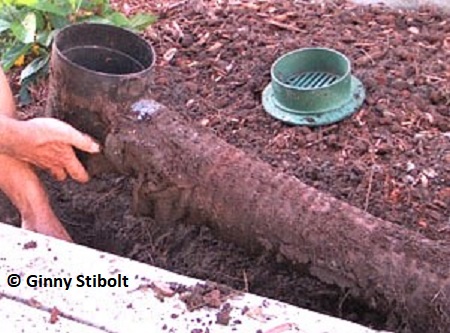 This French drain serves as drainage for both the driveway and the side and rear garden beds. |
While I love to garden, I'll do what I can to reduce routine maintenanceóin garden-lingo that means weeding. I was struck by the faintly snide comment by the former owner during our final walk-through when we bought our house last year: "Now you get to weed this garden." She was speaking of the front garden bed where a drainage system was covered with a layer of lava rocks. She was right: it was a weed magnet.
Over the last few weeks, my husband and I uncovered the drainage systems in both the front and side beds. For some reason, there are two types of systems. Then we put down weed barrier and remulched the beds. Before we look at our projects, here's some information on French drains.
(Update: I have learned the hard way that weed barrier cloth is useless in Florida for preventing weeds. Now, I use it only to keep rooks or gravel separated from soil in dry wells and such. But I have included this article in this collection, because of the information about the various setups of French drains, NOT our wasteful, heavy-handed, and expensive use of the weed barrier cloth.)
French drains
A French drain is a trench filled with rocks, gravel, sand or other pervious media constructed to absorb and direct water to a distant point. Sometimes the trench is lined with tiles. Modern French drains often include a porous, cloth-covered pipe for faster drainage and longer effectiveness. French drains are also known as blind drains because the entrance of water is by percolation and not open channels and most often they are not noticeable.
We had a vague idea that the use of "French" as the descriptor of the drainage system must have had its origin in Franceómaybe in wine country. Can't you just picture the vineyard managers cutting drainage ditches and then filling them with rocks so they could drive their work carts along the rows of grape vines? I found no evidence that this was the origin of the term.
I did see some articles that claimed that Romans used what we now call French drains in building their roads. French drains were discovered in the archeological digs at Monticello, but as far as I could find, Thomas Jefferson didn't call them that. One of my dictionaries says the term originated in 1770's.
Then I found an article that stated Henry French, a judge and a farmer in Concord, Massachusetts, wrote a book called, Farm Drainage, The Principles, Processes, and Effects of Draining Land with Stones, Wood, Plows, and Open Ditches and Especially with Tiles Including Tables of Rain-Fall, Evaporation, Filtration, Evacuation, Capacity of Pipes; Cost and Number to the Acre, of Tiles, Etc, Etc. Published in 1859, his book with the really long title was quite successful and he was well known in the area for designing drainage systems. People started to call the drains he designed French drains.
This article goes so far as to say that Judge French invented the French drain, and even if we use his name to describe the drainage system, we know he didn't invent it. Unless, maybe he was a Roman road engineer in one of his former lives. Hmm... The true etymology of the term may forever be unknown, but no matter where it originates, French drains make managing water flows easier.
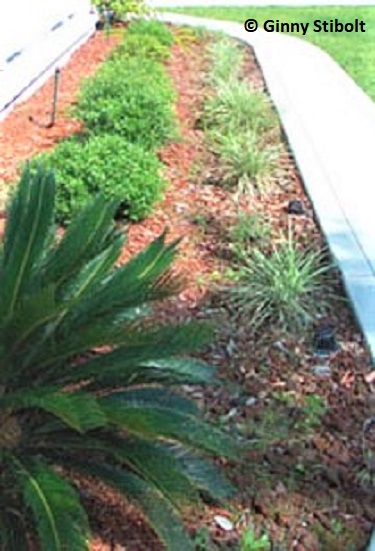 |
A highly visible weed magnet
It's downright embarrassing when the most visible garden of your house is always full of weeds no matter how much you work it. So after almost a year in our house, we finally got around to fixing this eyesore.
With a gardenia (Gardenia augusta) on one end and a sago (Cycas revoluta) on the other, the dwarf yaupon hollies (Ilex vomitoria 'Nana' (a male clone with no berries)) are lined up like so many gum drops in between. The liriope (Liriope muscari `Variegata') also known as lily turf had been planted in bunches along the front of the bed. And it was here that the weeds just loved it. (Liriope rhymes with calliope with the accent on the long "I" in the middle, in case you were wondering.)
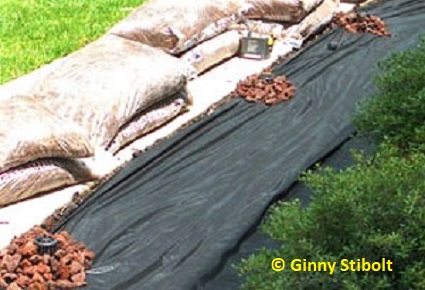 |
I took a deep breath before starting this project, because I knew it would take a while. We pulled out the lava rocks and dug out the liriope and the weeds. There was no weed barrier, hence the problem with the weeds. What were they thinking?
We discovered that the pipe with its drain cages popping up at irregular intervals was ordinary, impervious four-inch PVC. This meant that lava rock was not necessary for drainage and that this is not a true French drain because there's no percolation. The drain system begins under the downspout at the north end of the house (near the gardenia), then threads along the sidewalk, under the lawn, and out near the pond. I put a rain garden there to catch and slow down the water. (For more detail on rain gardens: Rain lilies for my rain gardens.)
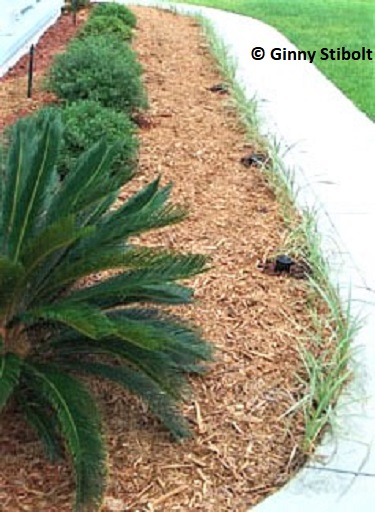 |
Having removed all the lava rock, we filled the bed with sand to bring it closer to the level of the drains. We put down black fiberglass cloth weed barrier. We rinsed off the lava rocks because they were filled with dirt and sand. We surrounded each drain cage with the washed rocks to keep the mulch out.
We decided to use the liriope along this bed, but as a real border and not in clumps. So when we put down the weed barrier, we left a two-inch gap and put down some good soil next to the sidewalk. We'll have to weed this area for a while until the Liriope fills in, but that shouldn't take too long. It's an indestructible, evergreen ground cover that has become invasive back in Maryland where we lived before.
I don't know what to plant between the hollies and the edge, but I'll know it when I see it. This bed gets full morning sun, but is shaded all afternoon. Any suggestions? (Update: A few years later, we gave up on the liriope border because the torpedo grass sent its aggressive runners under the sidewalk and it was impossible to keep neat. For several years, there were no border plants, the dwarf yaupon hollies had filled in to become a real hedge, and the gardenia died. Years later the hollies died back, the weed barrier cloth was removed and we now have a mostly native cottage wildflower garden between severely pruned hollies.)
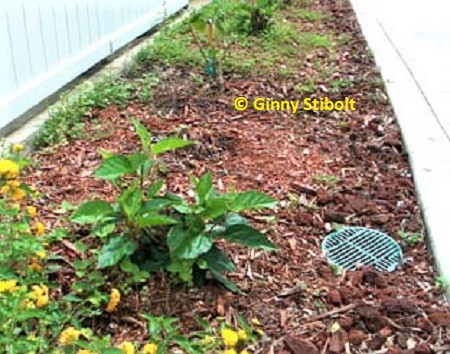 |
A true French drain
The side bed has a true French drain system. Pictured above, the flexible, porous pipe has a fiberglass cloth sleeve to keep sand and dirt from clogging the pipe. The termination drain at the end does very little for the drainage itself, but can serve as the entrance for a plumber's snake if the pipe becomes clogged. Having access to the drainage system will prolong its useful life.
This drain runs along the edge of the driveway, around the corner along the edge of the back flower bed and sidewalk where it accepts direct flow from two downspouts, before it heads out under the lawn out to the woods where it releases its flow into the drainage ditch from the pond to the lake. The rain garden that I installed there is more of a liner for the ditch so no erosion takes place before the water joins the pond overflow.
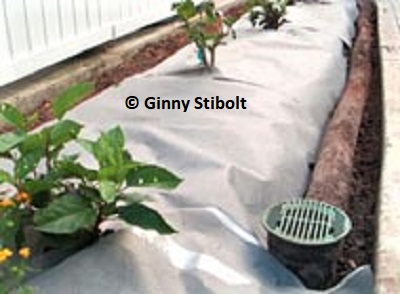 |
We removed the lava rocks, rinsed them off to remove the sand, and set them aside. We pulled out all the weeds and and graded the bed. At this point we laid down the weed barrier. We decided that we liked this unwoven weed barrier better than the black fiberglass cloth we used on the front bed, because fine roots cannot penetrate it. Even though I like the black color and the fact the the fiberglass cloth will stretch making it easier to install, we'll use the unwoven material for all future projects. If plants can't use it a growing medium, it will be effective for longer. Of course, there'll be the weeds that sprout from the top of the mulch, but generally, they are easier to handle. (Update: That was wishful thinking!)
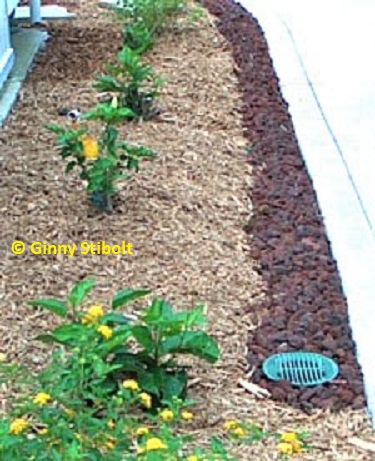 |
We laid the weed barrier to the bottom of the pipe to help keep out the dirt and then piled the freshly washed lava stones all along the pipe to slightly above the level of the driveway. After mulching the bed itself, the whole area looks much neater. And we hope that it will stay that way. Now I have to replace my leather gardening gloves, because after washing and working with all those darn lava rocks, there were holes in every finger.
We'll be planting some more sterile yellow lantana (Lantana camara) between the hibiscus (Hibiscus Rosa-sinensis) because it does really well in this location and stays pretty low to the ground. We'll just brush the mulch aside and slice a cross in the barrier when we plant the new bushes. Actually, I'm trying to root some lantana from the cuttings made as we trimmed back the bushes. More adventures on this later.
(Update: all of the tropical hibiscus were killed by a couple of colder-than-average winters, the sterile lantana did well for a while, but it's been replaced with natives and most of the weed barrier cloth is gone, too. One more note, we never use cypress mulch any more. It's not as sustainable as wood chips from local tree cutters.)
French drains are useful in Florida
Because of our five-month wet season in the summers (June through October: AKA Hurricane season) when we receive 70% of our annual rainfall, French drains can help handle those large volumes of water.
Ginny Stibolt is a life-long gardener, a botanist, a naturalist, and a garden writer. You may contact her or read more of her articles posted on her website: www.greengardeningmatters.com.
Copyright Ginny Stibolt

